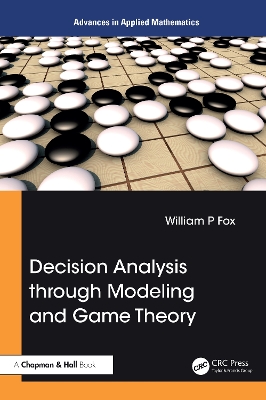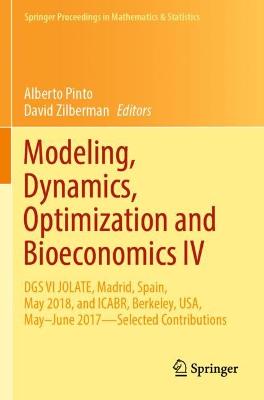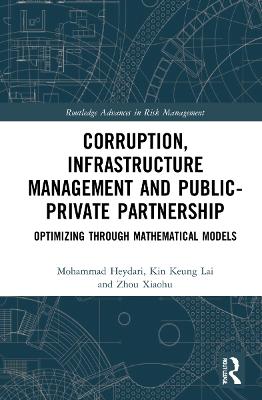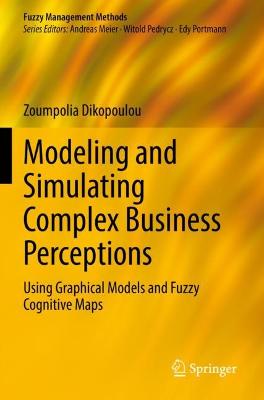Decision Analysis through Modeling and Game Theory
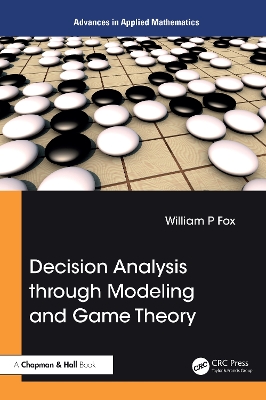 portes grátis
portes grátis
Decision Analysis through Modeling and Game Theory
Fox, William P.
Taylor & Francis Ltd
11/2024
296
Dura
9781032721606
Pré-lançamento - envio 15 a 20 dias após a sua edição
Descrição não disponível.
Chapter 1: Introduction to Decision Models
1.1 Overview of Decision Making
1.2 Decision Theory
1.3 Game Theory: Total Conflict
Example 1.5: A Total Conflict Game with Pure Strategies
1.4 Game Theory: Partial Conflict
1.5 Mathematical Modeling of Decisions
1.4 ILLUSTRATE EXAMPLES
1.5 Technology
Summary
Chapter 2 Decision Theory and Expected Value
2.1 Introduction
2.2 Expected Value
2.3 Decisions Under Risk: Probabilities are known or estimated in advance
2.4 Decisions under Uncertainty: Probabilities are not known nor can they be estimated
2.5 Decision Trees
2.6 Sequential Decisions and Conditional Probability (from Fox, Mathematical Modeling for Business Analytics, Taylor and Francis, 2018)
Chapter 3 Decisions under certainty: Mathematical Programming Modeling: Linear, Integer, and Mixed Integer Optimization
3.1 Introduction
3.2 Formulating Linear Programming Problems
3.3 Graphical Linear Programming
3.4 Linear Programming with Technology
3.5 Case Studies in Linear Programming
Projects
3.5.1 Modeling of Ranking Units using Data Envelopment Analysis (DEA) as a LP
3.5.2 Recruiting Raleigh Office (modified from McGrath, 2007)
Exercises
References and Suggested Further Readings
Chapter 4 Multi-Attribute Decision Making using weighting schemes with SAW, AHP and TOPSIS
4.1 Weighting Methods
4.1.1 Rank Order Centroid (ROC)
4.1.2 Ratio Method for Weights
4.1.3 Pairwise Comparison (AHP)
4.1.4 Entropy Method:
4.2 Simple Additive Weights (SAW) Method
4.3 Weighted Product Method
4.4 Analytical Hierarchy Process
4.5 Technique of Order Preference by Similarity to the Ideal Solution
Methodology
Normalization
Additional Reading and References
EXERCISES Chapter 4
CHAPTER 5 Game Theory: Total Conflict
5.1 Introduction to Total Conflict Games
5.2 Models with Pure Strategy Solutions
5.2.1 Movement Arrows with two players and a payoff matrix:
5.2.2 Saddle Point Method
5.3 Dominance and Dominated strategies
Exercises Section 5.1 Pure Strategy Games
5.3 Mixed Strategy in two player 2 strategy games
5.3 Linear Programming and Total Conflict Games
Summary
Chapter 6 Partial Conflict Games: The Classical Two-Player Games. Error! Bookmark not defined.
6.1 Partial Conflict Simultaneous Games Introduction
6.2 The Prisoner's Dilemma
6.3 The Game of Chicken
Reference and Further Readings
Chapter 7 Utility Theory
7.1 Introduction
7.2 Ordinal Numbers
7.3 Cardinal numbers
7.4 Utility
7.4 Von Neumann-Morgenstern Utilities Applied to Game Theory.
7.5 An alternative approach to the lottery method in utility theory for game theory
7.5.1 Lottery Method Illustrated
7.5.2 AHP Method
7.5.3 AHP Example in Game Theory
7.6 Summary and Conclusions
References
Chapter 8. Nash Equilibrium and Non-Cooperative Solutions in Partial Conflict Games
8.1 Introduction
8.2 Pure Strategies and Dominance review in symmetric games
8.3 Equalizing Strategies
8.4 Prudential Strategies with LP
8.5 Applications
EXERCISES
Chapter 9 Evolutionary stable Strategies
9.1 Introduction
Summary
Exercises Chapter 9
Reference
Chapter 10 Communications
10.1 Introduction
10.2 The Game of Chicken Without Communication
10.3 The Game of Chicken With Communication
10.3.1 Moving First or Committing to Move First
10.3.2 Issuing a Threat
10.3.3 Issuing a Promise
10.4 Credibility
Classical Game Theory and the Missile Crisis (from Brahm ,1994)
Theory of Moves and the Missile Crisis
Chapter 10 Exercises
References and Further Reading
Chapter 11 Nash Arbitration Method
11.1 Introduction to Nash Arbitration
11.2 Methods without calculus
11.3 More than two strategies
11.4 Writer's Guild Strike example with cardinal numbers
Introduction
Nash Arbitration Scheme
Chapter 12 Three Person Games
12.1 Three Person Zero-Sum games
12.2 Three-Person Partial Conflict Game ( Non-Zero Sum Game).
12.4 NON-ZERO Sum (non-constant sum) with no pure strategies.
12.5 3-Person game with Technology
Exercises
Chapter 13 Extensive Form Games
13.1 Introduction
Example 1. Kidnapping for ransom
Applying TOM
Exercises Chapter 13
1.1 Overview of Decision Making
1.2 Decision Theory
1.3 Game Theory: Total Conflict
Example 1.5: A Total Conflict Game with Pure Strategies
1.4 Game Theory: Partial Conflict
1.5 Mathematical Modeling of Decisions
1.4 ILLUSTRATE EXAMPLES
1.5 Technology
Summary
Chapter 2 Decision Theory and Expected Value
2.1 Introduction
2.2 Expected Value
2.3 Decisions Under Risk: Probabilities are known or estimated in advance
2.4 Decisions under Uncertainty: Probabilities are not known nor can they be estimated
2.5 Decision Trees
2.6 Sequential Decisions and Conditional Probability (from Fox, Mathematical Modeling for Business Analytics, Taylor and Francis, 2018)
Chapter 3 Decisions under certainty: Mathematical Programming Modeling: Linear, Integer, and Mixed Integer Optimization
3.1 Introduction
3.2 Formulating Linear Programming Problems
3.3 Graphical Linear Programming
3.4 Linear Programming with Technology
3.5 Case Studies in Linear Programming
Projects
3.5.1 Modeling of Ranking Units using Data Envelopment Analysis (DEA) as a LP
3.5.2 Recruiting Raleigh Office (modified from McGrath, 2007)
Exercises
References and Suggested Further Readings
Chapter 4 Multi-Attribute Decision Making using weighting schemes with SAW, AHP and TOPSIS
4.1 Weighting Methods
4.1.1 Rank Order Centroid (ROC)
4.1.2 Ratio Method for Weights
4.1.3 Pairwise Comparison (AHP)
4.1.4 Entropy Method:
4.2 Simple Additive Weights (SAW) Method
4.3 Weighted Product Method
4.4 Analytical Hierarchy Process
4.5 Technique of Order Preference by Similarity to the Ideal Solution
Methodology
Normalization
Additional Reading and References
EXERCISES Chapter 4
CHAPTER 5 Game Theory: Total Conflict
5.1 Introduction to Total Conflict Games
5.2 Models with Pure Strategy Solutions
5.2.1 Movement Arrows with two players and a payoff matrix:
5.2.2 Saddle Point Method
5.3 Dominance and Dominated strategies
Exercises Section 5.1 Pure Strategy Games
5.3 Mixed Strategy in two player 2 strategy games
5.3 Linear Programming and Total Conflict Games
Summary
Chapter 6 Partial Conflict Games: The Classical Two-Player Games. Error! Bookmark not defined.
6.1 Partial Conflict Simultaneous Games Introduction
6.2 The Prisoner's Dilemma
6.3 The Game of Chicken
Reference and Further Readings
Chapter 7 Utility Theory
7.1 Introduction
7.2 Ordinal Numbers
7.3 Cardinal numbers
7.4 Utility
7.4 Von Neumann-Morgenstern Utilities Applied to Game Theory.
7.5 An alternative approach to the lottery method in utility theory for game theory
7.5.1 Lottery Method Illustrated
7.5.2 AHP Method
7.5.3 AHP Example in Game Theory
7.6 Summary and Conclusions
References
Chapter 8. Nash Equilibrium and Non-Cooperative Solutions in Partial Conflict Games
8.1 Introduction
8.2 Pure Strategies and Dominance review in symmetric games
8.3 Equalizing Strategies
8.4 Prudential Strategies with LP
8.5 Applications
EXERCISES
Chapter 9 Evolutionary stable Strategies
9.1 Introduction
Summary
Exercises Chapter 9
Reference
Chapter 10 Communications
10.1 Introduction
10.2 The Game of Chicken Without Communication
10.3 The Game of Chicken With Communication
10.3.1 Moving First or Committing to Move First
10.3.2 Issuing a Threat
10.3.3 Issuing a Promise
10.4 Credibility
Classical Game Theory and the Missile Crisis (from Brahm ,1994)
Theory of Moves and the Missile Crisis
Chapter 10 Exercises
References and Further Reading
Chapter 11 Nash Arbitration Method
11.1 Introduction to Nash Arbitration
11.2 Methods without calculus
11.3 More than two strategies
11.4 Writer's Guild Strike example with cardinal numbers
Introduction
Nash Arbitration Scheme
Chapter 12 Three Person Games
12.1 Three Person Zero-Sum games
12.2 Three-Person Partial Conflict Game ( Non-Zero Sum Game).
12.4 NON-ZERO Sum (non-constant sum) with no pure strategies.
12.5 3-Person game with Technology
Exercises
Chapter 13 Extensive Form Games
13.1 Introduction
Example 1. Kidnapping for ransom
Applying TOM
Exercises Chapter 13
Este título pertence ao(s) assunto(s) indicados(s). Para ver outros títulos clique no assunto desejado.
Method of Laplace;Maximin Criterion;Decision Data Envelopment Analysis;Linear Programming;EXCEL
Chapter 1: Introduction to Decision Models
1.1 Overview of Decision Making
1.2 Decision Theory
1.3 Game Theory: Total Conflict
Example 1.5: A Total Conflict Game with Pure Strategies
1.4 Game Theory: Partial Conflict
1.5 Mathematical Modeling of Decisions
1.4 ILLUSTRATE EXAMPLES
1.5 Technology
Summary
Chapter 2 Decision Theory and Expected Value
2.1 Introduction
2.2 Expected Value
2.3 Decisions Under Risk: Probabilities are known or estimated in advance
2.4 Decisions under Uncertainty: Probabilities are not known nor can they be estimated
2.5 Decision Trees
2.6 Sequential Decisions and Conditional Probability (from Fox, Mathematical Modeling for Business Analytics, Taylor and Francis, 2018)
Chapter 3 Decisions under certainty: Mathematical Programming Modeling: Linear, Integer, and Mixed Integer Optimization
3.1 Introduction
3.2 Formulating Linear Programming Problems
3.3 Graphical Linear Programming
3.4 Linear Programming with Technology
3.5 Case Studies in Linear Programming
Projects
3.5.1 Modeling of Ranking Units using Data Envelopment Analysis (DEA) as a LP
3.5.2 Recruiting Raleigh Office (modified from McGrath, 2007)
Exercises
References and Suggested Further Readings
Chapter 4 Multi-Attribute Decision Making using weighting schemes with SAW, AHP and TOPSIS
4.1 Weighting Methods
4.1.1 Rank Order Centroid (ROC)
4.1.2 Ratio Method for Weights
4.1.3 Pairwise Comparison (AHP)
4.1.4 Entropy Method:
4.2 Simple Additive Weights (SAW) Method
4.3 Weighted Product Method
4.4 Analytical Hierarchy Process
4.5 Technique of Order Preference by Similarity to the Ideal Solution
Methodology
Normalization
Additional Reading and References
EXERCISES Chapter 4
CHAPTER 5 Game Theory: Total Conflict
5.1 Introduction to Total Conflict Games
5.2 Models with Pure Strategy Solutions
5.2.1 Movement Arrows with two players and a payoff matrix:
5.2.2 Saddle Point Method
5.3 Dominance and Dominated strategies
Exercises Section 5.1 Pure Strategy Games
5.3 Mixed Strategy in two player 2 strategy games
5.3 Linear Programming and Total Conflict Games
Summary
Chapter 6 Partial Conflict Games: The Classical Two-Player Games. Error! Bookmark not defined.
6.1 Partial Conflict Simultaneous Games Introduction
6.2 The Prisoner's Dilemma
6.3 The Game of Chicken
Reference and Further Readings
Chapter 7 Utility Theory
7.1 Introduction
7.2 Ordinal Numbers
7.3 Cardinal numbers
7.4 Utility
7.4 Von Neumann-Morgenstern Utilities Applied to Game Theory.
7.5 An alternative approach to the lottery method in utility theory for game theory
7.5.1 Lottery Method Illustrated
7.5.2 AHP Method
7.5.3 AHP Example in Game Theory
7.6 Summary and Conclusions
References
Chapter 8. Nash Equilibrium and Non-Cooperative Solutions in Partial Conflict Games
8.1 Introduction
8.2 Pure Strategies and Dominance review in symmetric games
8.3 Equalizing Strategies
8.4 Prudential Strategies with LP
8.5 Applications
EXERCISES
Chapter 9 Evolutionary stable Strategies
9.1 Introduction
Summary
Exercises Chapter 9
Reference
Chapter 10 Communications
10.1 Introduction
10.2 The Game of Chicken Without Communication
10.3 The Game of Chicken With Communication
10.3.1 Moving First or Committing to Move First
10.3.2 Issuing a Threat
10.3.3 Issuing a Promise
10.4 Credibility
Classical Game Theory and the Missile Crisis (from Brahm ,1994)
Theory of Moves and the Missile Crisis
Chapter 10 Exercises
References and Further Reading
Chapter 11 Nash Arbitration Method
11.1 Introduction to Nash Arbitration
11.2 Methods without calculus
11.3 More than two strategies
11.4 Writer's Guild Strike example with cardinal numbers
Introduction
Nash Arbitration Scheme
Chapter 12 Three Person Games
12.1 Three Person Zero-Sum games
12.2 Three-Person Partial Conflict Game ( Non-Zero Sum Game).
12.4 NON-ZERO Sum (non-constant sum) with no pure strategies.
12.5 3-Person game with Technology
Exercises
Chapter 13 Extensive Form Games
13.1 Introduction
Example 1. Kidnapping for ransom
Applying TOM
Exercises Chapter 13
1.1 Overview of Decision Making
1.2 Decision Theory
1.3 Game Theory: Total Conflict
Example 1.5: A Total Conflict Game with Pure Strategies
1.4 Game Theory: Partial Conflict
1.5 Mathematical Modeling of Decisions
1.4 ILLUSTRATE EXAMPLES
1.5 Technology
Summary
Chapter 2 Decision Theory and Expected Value
2.1 Introduction
2.2 Expected Value
2.3 Decisions Under Risk: Probabilities are known or estimated in advance
2.4 Decisions under Uncertainty: Probabilities are not known nor can they be estimated
2.5 Decision Trees
2.6 Sequential Decisions and Conditional Probability (from Fox, Mathematical Modeling for Business Analytics, Taylor and Francis, 2018)
Chapter 3 Decisions under certainty: Mathematical Programming Modeling: Linear, Integer, and Mixed Integer Optimization
3.1 Introduction
3.2 Formulating Linear Programming Problems
3.3 Graphical Linear Programming
3.4 Linear Programming with Technology
3.5 Case Studies in Linear Programming
Projects
3.5.1 Modeling of Ranking Units using Data Envelopment Analysis (DEA) as a LP
3.5.2 Recruiting Raleigh Office (modified from McGrath, 2007)
Exercises
References and Suggested Further Readings
Chapter 4 Multi-Attribute Decision Making using weighting schemes with SAW, AHP and TOPSIS
4.1 Weighting Methods
4.1.1 Rank Order Centroid (ROC)
4.1.2 Ratio Method for Weights
4.1.3 Pairwise Comparison (AHP)
4.1.4 Entropy Method:
4.2 Simple Additive Weights (SAW) Method
4.3 Weighted Product Method
4.4 Analytical Hierarchy Process
4.5 Technique of Order Preference by Similarity to the Ideal Solution
Methodology
Normalization
Additional Reading and References
EXERCISES Chapter 4
CHAPTER 5 Game Theory: Total Conflict
5.1 Introduction to Total Conflict Games
5.2 Models with Pure Strategy Solutions
5.2.1 Movement Arrows with two players and a payoff matrix:
5.2.2 Saddle Point Method
5.3 Dominance and Dominated strategies
Exercises Section 5.1 Pure Strategy Games
5.3 Mixed Strategy in two player 2 strategy games
5.3 Linear Programming and Total Conflict Games
Summary
Chapter 6 Partial Conflict Games: The Classical Two-Player Games. Error! Bookmark not defined.
6.1 Partial Conflict Simultaneous Games Introduction
6.2 The Prisoner's Dilemma
6.3 The Game of Chicken
Reference and Further Readings
Chapter 7 Utility Theory
7.1 Introduction
7.2 Ordinal Numbers
7.3 Cardinal numbers
7.4 Utility
7.4 Von Neumann-Morgenstern Utilities Applied to Game Theory.
7.5 An alternative approach to the lottery method in utility theory for game theory
7.5.1 Lottery Method Illustrated
7.5.2 AHP Method
7.5.3 AHP Example in Game Theory
7.6 Summary and Conclusions
References
Chapter 8. Nash Equilibrium and Non-Cooperative Solutions in Partial Conflict Games
8.1 Introduction
8.2 Pure Strategies and Dominance review in symmetric games
8.3 Equalizing Strategies
8.4 Prudential Strategies with LP
8.5 Applications
EXERCISES
Chapter 9 Evolutionary stable Strategies
9.1 Introduction
Summary
Exercises Chapter 9
Reference
Chapter 10 Communications
10.1 Introduction
10.2 The Game of Chicken Without Communication
10.3 The Game of Chicken With Communication
10.3.1 Moving First or Committing to Move First
10.3.2 Issuing a Threat
10.3.3 Issuing a Promise
10.4 Credibility
Classical Game Theory and the Missile Crisis (from Brahm ,1994)
Theory of Moves and the Missile Crisis
Chapter 10 Exercises
References and Further Reading
Chapter 11 Nash Arbitration Method
11.1 Introduction to Nash Arbitration
11.2 Methods without calculus
11.3 More than two strategies
11.4 Writer's Guild Strike example with cardinal numbers
Introduction
Nash Arbitration Scheme
Chapter 12 Three Person Games
12.1 Three Person Zero-Sum games
12.2 Three-Person Partial Conflict Game ( Non-Zero Sum Game).
12.4 NON-ZERO Sum (non-constant sum) with no pure strategies.
12.5 3-Person game with Technology
Exercises
Chapter 13 Extensive Form Games
13.1 Introduction
Example 1. Kidnapping for ransom
Applying TOM
Exercises Chapter 13
Este título pertence ao(s) assunto(s) indicados(s). Para ver outros títulos clique no assunto desejado.

